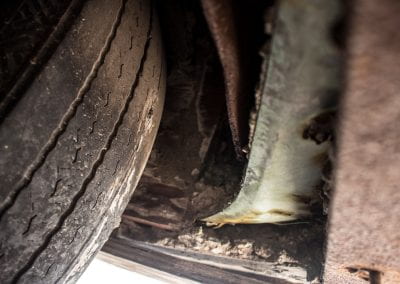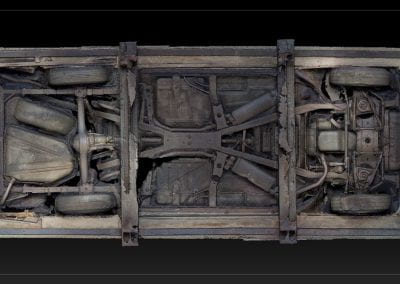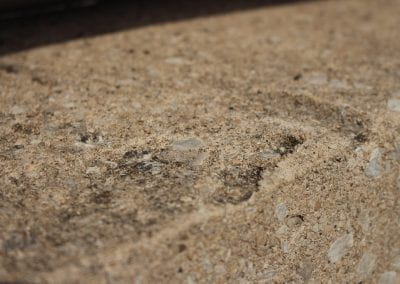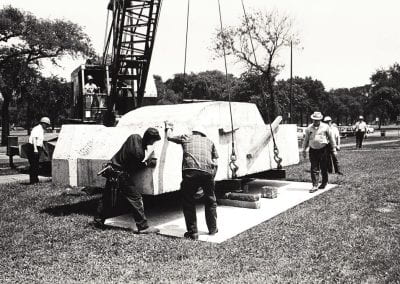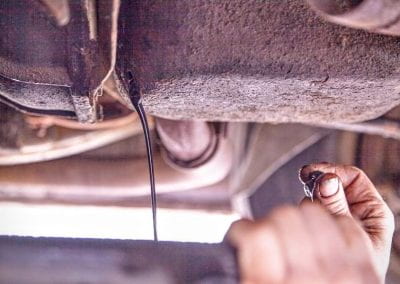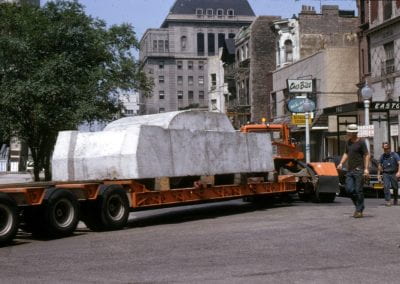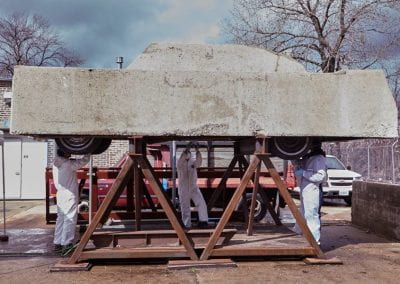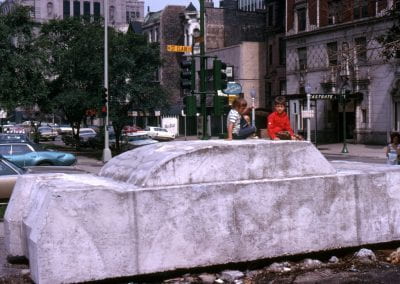Exhibitions
Concrete Happenings: Fall 2016 – Spring 2017
Don’t just look at art. Grapple with it.

Detail of Wolf Vostell’s Concrete Traffic, 1970, after it arrived at its new location at the east entrance to the University of Chicago Campus North Parking Garage. (Photo by Erik L. Peterson).
The Logan Center for the Arts, Neubauer Collegium, Smart Museum of Art, and Special Collections—all free and within walking distance from the Concrete Traffic sculpture site—delved into the stories behind Concrete Traffic through a series of exhibitions.
Exhibition Archive
Retrogarde
November 11, 2016–January 1, 2017 | Reception: November 11, 2016, 6–8pm
Exhibition hours: Tuesday through Saturday, 9am–9pm; Sunday, 11am–9pm
Logan Center Gallery, Reva and David Logan Center for the Arts, 915 East 60th Street
Retrogarde is an international group exhibition that explores contemporary artists’ recuperation and appropriation of avant-garde strategies, histories, and archives in their work. Conceptually and formally, the works in this exhibition adopt a series of recognizable avant-garde forms—fusing play with the profane; detourning language, space, and matter; and working through performative actions and interventions—to address the politics of everyday life. Taken together these works highlight the continued relevance of avant-garde perspectives today. Yet the artists’ attitude towards this lineage is not one of blind veneration but rather pervasive disobedience, mirroring the transgressive actions of their predecessors. Consequently, Retrogarde infuses other viewpoints, narratives, and contexts to open up our collective reading of avant-garde traditions. Artists in the exhibition include Caroline Bergvall, Samson Kambalu, Matthew Metzger, Catherine Sullivan and Samson Young.
Curator: Yesomi Umolu, Exhibitions Curator, Logan Center for the Arts.
Presented by Logan Center Exhibitions.
Instructions for a Chicago Fluxus Opening
Sunday, January 22, 2017, 3–6pm
Neubauer Collegium for Culture and Society (5701 South Woodlawn Avenue), Special Collections Research Center, University of Chicago Library (1100 East 57th Street), Smart Museum of Art (5550 South Greenwood Avenue)
A set of “instructions”—inspired by participatory Happenings orchestrated by Fluxus artist Wolf Vostell—will guide you across the University of Chicago campus during this opening celebration for three related exhibitions: Fantastic Architecture (Neubauer Collegium), Concrete Poetry, Concrete Book (Special Collections Research Center), and Vostell Concrete (Smart Museum). Enjoy a variety of free programs, food, and drinks at the three locations. A free shuttle will run between locations.
Free, open to all. Drop by or RSVP on Facebook.
Presented by the Neubauer Collegium for Culture and Society, Special Collections Research Center, and Smart Museum of Art. The exhibitions and related programming have been made possible in part by the generous support of the Pamela and R. Christopher Hoehn-Saric Exhibition Fund, the Graham Foundation for Advanced Studies in the Fine Arts, the Swiss Benevolent Society, the Austrian Cultural Forum New York, SmartPartners, and Ozinga Bros., Inc.
Concrete Poetry, Concrete Book: Artists’ Books in German-speaking Space after 1945
January 17–March 17, 2017 | Reception: Sunday, January 22, 2017, 3–6pm
Exhibition hours: Monday through Friday, 9am–4:45pm; and, when University of Chicago classes are in session, Tuesdays and Wednesdays, 9am–5:45pm
Special Collections Research Center, University of Chicago Library, 1100 East 57th Street
In the same decades that artists affiliated with Fluxus explored action-based, performative strategies set on disrupting the conventions of both art and everyday life, the book emerged as a significant artistic preoccupation. Not only were books important for anthologizing ephemeral action-based art, but they became in their own right sites of artistic experimentation with cognitive, visual, and tactile experience. Drawing on the remarkable collection of rare artists’ books housed in the University of Chicago Library, Concrete Poetry, Concrete Book explores how artists in Austria, Germany, and Switzerland investigated the material and technical forms of the book. Referring to the way that language takes up space on the page, arrests the eyes, and insists on physical interaction, works of konkrete poesie (concrete poetry) tested the material display of language, focusing on the object-quality of letters and words. To accommodate this dual staging of textual production and reception, artists’ books took on unusual forms, as in Gerhard Rühm’s kinetic book bewegung (motion, 1964) and Hansjörg Mayer’s reinvention of the alphabet in the fold-out book typoaktionen (type-actions, 1967). At the same time that artists’ books often activate the process of reading, they also deemphasize textual cognition, foregrounding instead touch and materiality, as exemplified in die-cut multi-colored cellophane pages of Dieter Roth’s bilderbücher (picture-books, 1957) and in Wolf Vostell’s unreadable 20-pound Betonbuch (Concrete Book, 1971). In tandem with Concrete Happenings, interactive workshops will provide unique opportunities for hands-on engagement with artists’ books, and a series of public lectures will provide further perspective on the concrete questions they raise about language, materiality, performance, and collaboration.
Curator: Caroline Lillian Schopp, PhD candidate in the Department of Art History.
Presented by the University of Chicago Library, with additional support generously provided by the Swiss Benevolent Society and the Austrian Cultural Forum New York.
Fantastic Architecture: Vostell, Fluxus, and the Built Environment
January 22–March 17, 2017 | Reception: Sunday, January 22, 2017, 3–6pm
Exhibition hours: Monday through Friday, 11am–5pm
Neubauer Collegium for Culture and Society, 5701 South Woodlawn Avenue
Taking its title and inspiration from the seminal publication Fantastic Architecture (1969), edited by Wolf Vostell and Dick Higgins and published by Something Else Press, this exhibition presents various approaches to architecture, urban space, and the built environment within an expanded international community of Fluxus and related artists in the late 1960s and early 1970s. Fantastic Architecture is presented in conjunction with the re-siting, following a major conservation treatment, of Wolf Vostell’s Concrete Traffic (1970), a monumental event-sculpture in the University of Chicago’s Campus Art Collection. The exhibition contextualizes Concrete Traffic in relation to Vostell’s other related works from the period, including photomontage proposals for alterations to architectural and urban spaces and event scores for happenings intended for specific cities, as well as the work of his artistic peers and interlocutors. In Europe and the United States alike, the postwar period saw massive transformations of the urban landscape, the construction and expansion of freeway systems, and the rise of automobile culture, and artists of the time responded to these developments in a variety of ways. Like its eponymous exemplar, the exhibition embraces the porousness and intellectual ferment of the experimental art world of the time, a context in which forms and concepts circulated among an international community of artists whose political and aesthetic projects did not always strictly align. Also included are works and projects by Fluxus impresario George Maciunas, Japanese collective Hi Red Center, happenings inventor Allan Kaprow, conceptual artist Douglas Huebler, and artist and poet Rosemary Mayer, and others.
Curator: Jacob Proctor, Curator, Neubauer Collegium for Culture and Society.
Presented by the Neubauer Collegium for Culture and Society, with additional support from the Graham Foundation for Advanced Studies in the Fine Arts.
Vostell Concrete, 1969–1973
January 17–June 11, 2017 | Reception: Sunday, January 22, 2017, 3–6pm
Exhibition hours: Tuesday through Sunday, 10am–5pm; Thursday until 8pm
Smart Museum of Art, 5550 South Greenwood Avenue
Vostell used concrete as an actual material and artistic motif in a surprising number of ways in the late 1960s and early 70s. During this time, Vostell mobilized concrete’s ambivalent connotations of permanence and inflexibility, strength and violence, to engage with postwar urbanism, particularly German reconstruction and American urban renewal; with unrest and war, including the civil rights marches in Selma, the Paris student protests, the Vietnam and Cold wars; and with the international, if not yet global world, particularly as manifest in transatlantic travel, postcards, and the Munich Olympics. Vostell Concrete is animated by questions of why the materials of art making matter and what they signify. It features the artist’s little known, first uses of concrete and redresses a too-limiting understanding of Vostell as a mere performance artist or belated German Pop artist. Drawn from the Smart Museum and other local, national, and international collections, the approximately 45 works on view span a variety of media, from sculpture to film, performance, collage, watercolor, and printmaking.
Curators: Christine Mehring, Professor and Chair, Department of Art History, in collaboration with Diane Miliotes, Interim Curator of Modern Art and Design, Smart Museum of Art, and Caroline Lillian Schopp, Curatorial Research Associate and PhD Candidate in Art History.
This exhibition has been made possible in part by the Smart Museum’s Pamela and R. Christopher Hoehn-Saric Exhibition Fund, Amy L. Gold, the Graham Foundation for Advanced Studies in the Fine Arts, and SmartPartners.
Related Links
Video
Concrete Traffic’s Procession to the University of Chicago
Concrete Happenings
Gallery
Click on the image to zoom in
A rare view of Concrete Traffic (1970). Photogrammetry by JP Brown, The Field Museum, Chicago (2 of 8)
Concrete Traffic’s installation in front of Midway Studios, June 1970. Photo by Jean-Claude LeJeune. Collection of the Museum of Contemporary Art Chicago Library and Archives. Photo © MCA Chicago. (4 of 8)
Conservation of Concrete Traffic’s undercarriage. Photo by Stephen Murphy, courtesy of Chicago Vintage Motor Carriage. (5 of 8)
Transportation of Concrete Traffic to the University of Chicago, June 1970. Collection of the Museum of Contemporary Art Chicago Library and Archives. Photo © MCA Chicago. (6 of 8)
Concrete Traffic Conservation. Photo by Stephen Murphy, courtesy of Chicago Vintage Motor Carriage (7 of 8)

